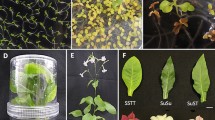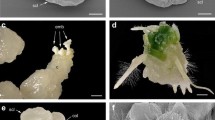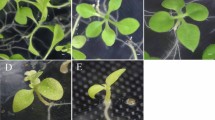Abstract
Reproductive isolation mechanisms (RIMs) often become obstacles in crossbreeding. Hybrid lethality is a subtype of RIM but its physiological mechanism remains poorly elucidated. Interspecific hybrids of Nicotiana suaveolens Lehm. × N. tabacum L. cv. Hicks-2 expressed temperature-sensitive lethality. This lethality was induced by programmed cell death (PCD) that was accompanied by the characteristic changes of animal apoptosis in hybrid seedlings at 28 °C but not at 36 °C. When hybrid seedlings were cultured at 28 °C, DNA fragmentation started in the cotyledon, and nuclear fragmentation subsequently progressed with lethal symptoms spreading throughout the seedlings. At 28 °C, ethylene production in hybrid seedlings was detectable at a high level compared with the level in parental seedlings. In contrast, the ethylene production rate in hybrid seedlings cultured at 36 °C was equal to that in parental seedlings. Treatment with ethylene biosynthetic inhibitors, amino-oxyacetic acid and amino-ethoxyvinyl glycine, suppressed lethal symptoms and apoptotic changes, and also prolonged survival of hybrid seedlings. Thus, the increase in the ethylene production rate correlated closely with expression of lethal symptoms and apoptotic changes in hybrid seedlings. From these observations, we conclude that overproduced ethylene acts as an essential factor mediating PCD and subsequent lethality in hybrid seedlings. Furthermore, the present study has provided the first evidence that ethylene is involved in the phenomenon of hybrid lethality.




Similar content being viewed by others
Abbreviations
- AOA:
-
amino-oxyacetic acid
- AVG:
-
amino-ethoxyvinyl glycine
- CTAB:
-
cetyltrimethylammonium bromide
- DAG:
-
days after germination
- PCD:
-
programmed cell death
- RIMs:
-
reproductive isolation mechanisms
References
Abeles FB, Morgan PW, Saltveit Jr ME (2000) Ethylene in plant biology, 2nd edn. Academic Press, San Diego
Afford S, Randhawa S (2000) Apoptosis. Mol Pathol 53:55–63
Asai T, Stone JM, Heard JE, Kovtun Y, Yorgey P, Sheen J, Ausubel FM (2000) Fumonisin B1-induced cell death in arabidopsis protoplasts requires jasmonate-, ethylene-, and salicylate-dependent signaling pathways. Plant Cell 12:1823–1836
Atta-Aly M (1992) Effect of high temperature on ethylene biosynthesis by tomato fruit. Postharvest Biol Technol 2:19–24
De Jong AJ, Hoeberichts FA, Yakimova ET, Maximova E, Woltering EJ (2000) Chemical-induced apoptotic cell death in tomato cells: involvement of caspase-like proteases. Planta 211:656–662
De Jong AJ, Yakimova ET, Kapchina VM, Woltering EJ (2002) A critical role for ethylene in hydrogen peroxide release during programmed cell death in tomato suspension cells. Planta 214:537–545
Hanania U, Furman-Matarasso N, Ron M, Avni A (1999) Isolation of a novel SUMO protein from tomato that suppresses EIX-induced cell death. Plant J 19:533–541
He C-J, Morgan PW, Drew MC (1996) Transduction of an ethylene signal is required for cell death and lysis in the root cortex of maize during aerenchyma formation induced by hypoxia. Plant Physiol 112:463–472
Iwai S, Kishi C, Nakata K, Kawashima N (1986) Production of Nicotiana tabacum × Nicotiana acuminata hybrid by ovule culture. Plant Cell Rep 5:403–404
Jones AM (2001) Programmed cell death in development and defence. Plant Physiol 125:94–97
Lloyd R (1975) Tissue culture as a means of circumventing lethality in an interspecific Nicotiana hybrid. Tob Sci XIX:4–6
Lund ST, Stall RE, Klee HJ (1998) Ethylene regulates the susceptible response to pathogen infection in tomato. Plant Cell 10:371–382
Lurie S, Handros A, Fallik E, Shapira R (1996) Reversible inhibition of tomato fruit gene expression at high temperature. Plant Physiol 110:1207–1214
Marubashi W, Kobayashi M (2002) Temperature-dependent apoptosis detected in hybrid between Nicotiana debneyi and N. tabacum expressing lethality. Plant Biotechnol 19: 267–270
Marubashi W, Yamada T, Niwa M (1999) Apoptosis detected in hybrids between Nicotiana glutinosa and N. repanda expressing lethality. Planta 210:168–171
Mayr E (1963) Animal species and evolution. Belknap Cambridge, MA
Murashige T, Skoog F (1962) A revised medium for rapid growth and bio assays with tobacco tissue cultures. Physiol Plant 15:473–497
Oka H-I, Doida Y (1962) Phylogenetic differentiation of cultivated rice, XX. Analysis of the genetic basis of hybrid breakdown in rice. Jpn J Genet 37:24–35
Orzáez D, Granell A (1997) The plant homologue of the defender against apoptotic death gene is down-regulated during senescence of flower petals. FEBS Lett 404:275–278
Overmyer K, Tuominen H, Kettunen R, Betz C, Langebartels C, Sandermann Jr H, Kangasjärvi J (2000) Ozone-sensitive Arabidopsis rcd1 mutant reveals opposite roles for ethylene and jasmonate signaling pathways in regulating superoxide-dependent cell death. Plant Cell 12:1849–1862
Phillips LL (1977) Interspecific incompatibility in Gossypium. IV. Temperature-conditional lethality in hybrids of G. klotzschianum. Am J Bot 64:914–915
Provine WB (1991) Alfred Henry Sturtevant and crosses between Drosophila melanogaster and Drosophila simulans. Genetics 129:1–5
Samora PJ, Stelly DM, Kohel RJ (1994) Localization and mapping of the Le 1 and Gl 2 loci of cotton (Gossypium hirsutum L.). J Hered 85:152-157
Sharma HC, Ohm HW (1990) Crossability and embryo rescue enhancement in wide crosses between wheat and three Agropyron species. Euphytica 49:209–214
Stebbins GL (1966) Reproductive isolation and the origin of species. In: Processes of organic evolution. Prentice-Hall, New Jersey, pp 85–112
Woltering EJ, De Jong AJ, Yakimova ET (1999) Apoptotic cell death in plants: the role of ethylene. In: AK Kanellis (ed) Biology and biotechnology of the plant hormone ethylene II. Kluwer, Dordrecht, pp 209–216
Yamada T, Marubashi W, Niwa M (1999) Detection of four lethality types in interspecific crosses among Nicotiana species through the use of three rescue methods for lethality. Breed Sci 49:203–210
Yamada T, Marubashi W, Niwa M (2000) Apoptotic cell death induces temperature-sensitive lethality in hybrid seedlings and calli derived from the cross of Nicotiana suaveolens × N. tabacum. Planta 211:614–622
Yamada T, Marubashi W, Nakamura T, Niwa M (2001a) Possible involvement of auxin-induced ethylene in an apoptotic cell death during temperature-sensitive lethality expressed by hybrid between Nicotiana glutinosa and N. repanda. Plant Cell Physiol 42:923–930
Yamada T, Takatsu Y, Kasumi M, Manabe T, Hayashi M, Marubashi W, Niwa M (2001b) Novel evaluation method of flower senescence in freesia (Freesia hybrida) based on apoptosis as an indicator. Plant Biotech 18:215–218
Yang SF, Hoffman NE (1984) Ethylene biosynthesis and its regulation in higher plants. Annu Rev Plant Physiol 35:155–189
Young TE, Gallie DR (2000) Regulation of programmed cell death in maize endosperm by abscisic acid. Plant Mol Biol 42:397–414
Zeven AC (1981) Eighth supplementary list of wheat varieties classified according to their genotype for hybrid necrosis. Euphytica 30:521–539
Acknowledgement
This work was partly supported by Grant-in Aid for Exploratory Research No. 12876002 and Scientific Research (A) No. 13306003 from the Ministry of Education, Science, Sports and Culture, Japan.
Author information
Authors and Affiliations
Corresponding author
Additional information
T. Yamada is a Domestic Research Fellow at the National Institute of Floricultural Science
Rights and permissions
About this article
Cite this article
Yamada, T., Marubashi, W. Overproduced ethylene causes programmed cell death leading to temperature-sensitive lethality in hybrid seedlings from the cross Nicotiana suaveolens × N. tabacum . Planta 217, 690–698 (2003). https://doi.org/10.1007/s00425-003-1035-2
Received:
Accepted:
Published:
Issue Date:
DOI: https://doi.org/10.1007/s00425-003-1035-2




